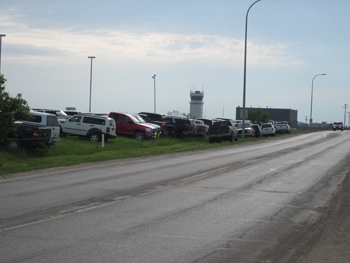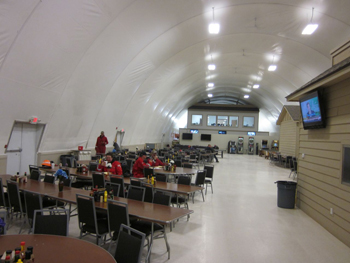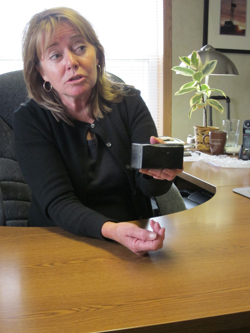To find people in North Dakota connected to the boom in the state’s oil patch, just stand still at an airport and they’ll walk by. That is, if they were able to find a parking space.
There’s the truck driver just off his two-week stint in the field and headed back to Texas, which he left when his boss said he could move from $16 an hour to a triple-figure salary. He’d missed his flight the day before because he overslept after an 18-hour day.
There’s the young computer expert who’s solved the state’s worker housing dilemma for himself, at least. He gets to stay in a nicely sized trailer by virtue of that trailer’s dedicated purpose: housing the equipment he tends.
And there’s the grandmother complaining of how the hotels are price-gouging the workers in her boomtown, charging $1,500 a month for tiny rooms.
If the croprows in the famously rich soil of the state’s Red River Valley to the east are as straight as technically possible, the beeline to the future in western North Dakota has a few more twists and turns. And it’s not just because that’s the topography of the badlands.
The pace of activity is literally feverish. Just ask Gene Veeder, economic development director for the McKenzie County Job Development Authority, based in hectic Watford City. He’s just getting over the cold that everybody seems to have caught recently. But that doesn’t hide his contagious excitement about the possibilities for his hometown.
“I might talk to five or 10 CEOs a week about multimillion-dollar investments,” he says. “We’re playing catch-up, with a lot of interest in retail.” That’s evident at a new mini-mall across the street from the town’s Creekside Condos. Two motels and a package store are coming soon.
“We need those in order to get to any next step with economic diversification,” says Veeder, who also handles water planning for the city as it approaches the 10,000 population watermark.
“Our ordinance book is too thin,” admits Mayor Brent Sanford, citing a new restaurant-class liquor license just created last year. “There was no county zoning — you just negotiated with your neighbor. That worked for 100 years, but it isn’t working now.”
The push for basic construction materials and labor is driving the cost for current commercial projects in town to $16 per sq. ft., says Veeder. Water trucks serving the oil sites wait in line to get water from a single municipal well spigot. Nearby a food truck waits to serve the truck drivers. And there’s usually a line at the state-controlled package store: “Definitely a bigger market for beer,” says one observer.
Dick Hedahl, president of Bismarck-based Hedahl’s Auto Parts, says his company has owned stores in the formerly quiet towns of the West since the 1930s. In 2005 his company bought five more stores in a package deal, including a couple sleepy little stores that Hedahl says he didn’t really want. “Our sales volume has gone through the roof,” he says. But the pinch comes in retaining workers.
“I was giving monthly raises last summer,” he says. “It’s crazy, because you start chasing uphill and don’t know where the top is. At a McDonalds near my store they were paying $16 an hour plus a $400 signing bonus. And they were closed in the evenings, because they didn’t have enough help to keep the dining room open.”
One of the state’s highest-volume Walmart stores is nearby, he says, “but they don’t stock the shelves anymore. They just set the pallets out in the aisle and customers start picking them clean.”
Solutions on the Way

Asked what the state’s doing to keep up with infrastructure demands, North Dakota Gov. Jack Dalrymple says, “The simple answer is we’re currently spending $1.2 billion of state money in our 17 oil-and-gas-producing counties in our current budget cycle. And we are catching up as fast as we can with road rebuilding, water supply, housing, law enforcement and emergency services. I have no doubt that the next budget cycle we’ll probably have to do it again. There’s no sign the pace of development is slowing down at all. We believe we can and will keep up.”
“I’ve been involved in several Bakken investor conferences lately, and what we see is the private sector nationally has taken hold of this,” says Eric Hardmeyer, president and CEO of the Bank of North Dakota. “They’re going to chase a return, and they’re starting to believe this thing is real. I think we’re going to see a lot of private dollars coming in” to solve some of the state’s housing and infrastructure issues, he says.
Dalrymple says there’s been a lack of scale with housing developments, though out-of-town investors recently broke through with two developments in Williston that will total 1,300 units. Still, he says, “There is no getting around the fact that if you’re thinking of moving to Williston, it’s a pretty frantic place right now. That’s something everybody should know. Don’t drive there thinking you’re going to rent an apartment, because you won’t find one.”
Of the 20,000 to 25,000 job openings in North Dakota this spring,
between 30 and 35 percent were in the oil patch.
The housing bottleneck is being cleared one project at a time. In Watford City, the Pheasant Ridge development was recently annexed into city limits, and will feature both single-family and multifamily residences on a 36-acre (14-hectare) parcel.
Communities outside the oil patch are doing their part. Bismarck-Mandan is more than two hours from the nearest rig, but has seen an influx of white-collar employers serving the oil & gas sector, in part because “we are the state capital, we have the most flights and we have available hotel rooms,” says Brian Ritter, director of business development for the Bismarck-Mandan Development Association. The area is seeing residential impact as well, due in part to the way oil patch shift schedules work. “With four or five days on, then four or five days off, people are coming here to take advantage,” says Ritter.
Companies too are staging office staff at a distance: Witness recent locations of such administrative hubs from Hess and Halliburton in Minot. But even in the cities, there are real estate issues. “The joke is there are more realtors than houses for sale in Bismarck,” says one informed insider.
Meanwhile, mixed-use projects are popping up in Minot and in small towns such as Crosby, which was losing population not that long ago. That was before the town was host to the state’s first successful horizontal well using fracture stimulation technology to drill in the Bakken formation. Last November, Continental Resources CEO Harold Hamm attended the dedication of a monument erected to commemorate that well and its landowner Robert Heuer. Hamm thinks up to 50,000 wells might eventually be drilled to access up to 24 billion gallons of oil equivalent.
A Visit to a Crew Camp

In Tioga, Hess is investing $350 million in an expansion of its gas plant, including a rail siding with room for 100-car unit trains that looks like a racetrack when it’s all lit up at night. It might as well be. Black Gold Suites charges $210 a night at its new hotel in Tioga. Hess itself, which used to be headquartered in Williston, has moved its office staff to Minot in part because of the housing dilemma.
Kathy Neset is a geologist who heads a growing energy consulting firm based in Tioga. She hails from New Jersey, and attended Brown University before coming to North Dakota in 1979. She’s gradually expanded her offices, which administer for work by crews on 90 different oil rigs. She bought the original lot for $5,000, then added an outbuilding with another $500. The site today is valued at $50,000.
Neset and her husband have two children working in her field and making very healthy incomes just a year removed from college. And she’s encouraged by two trends joined at the hip: more sophisticated technology and less environmental impact. Staged fracking, with constantly improving tools, enables more oil recovery in the pay zone while also allowing the land to recover.
“It’s not like a vast cavern down there,” says Neset. “All we’re doing is cracking it, and then we just draw the oil through it.” On the surface, the latest generation of “eco-pads” means less disturbance, and when the drilling is done, “everything gets totally reclaimed,” says Neset. “The surface disturbance is incredibly less than it used to be. It’s amazing.”
The surface disturbance caused by all the activity surrounding that drilling? Well, it’s amazing too. Roads made for combines are being eaten up by 40,000-pound water trucks. And though roads are being covered with dust-control measures, there’s enough dust constantly in the air to worry farmers for whom dust is like shade on their crops.
The people continue to pour in as resolutely as the oil is drawn out: Truck drivers from Michigan and the Twin Cities, experienced rig workers from the Gulf Coast or mine workers from Wyoming and Montana, largely Hispanic construction and pipeline crews introducing a new culture to the High Plains. There are tales of folks holed up in trailers insulated with hay bales. There are pop-up RV villages. And there are the so-called “man camps,” professionally run crew camp installations that cater to the crew housing needs of the oil service firm big boys. In a blend of barracks and gated community (no alcohol, no cohabitation), the camps are where an exhausted worker can find respite, food and at least a semblance of a social life.
On the outskirts of Tioga, facing each other across a busy highway, sit a Target Logistics camp and a new player in town called Capital Lodge. The latter project is the result of a plan hatched just last August by New Orleans real estate developer Kenny Lobelle and Mike Boudreaux, a native Mississippian who heads the operation at Lobelle’s behest and who was surprised when he first heard his friend’s idea last summer.
“I thought, “This guy is losing his mind. What is up there?’ ” says Boudreaux. “I’d heard about the opportunity, but not to the magnitude it is.” Lobelle’s first inkling was a trucking operation, but the concept turned to a crew camp quickly when it became evident that any truckers coming up from the bayou had no place to stay. It was time to make the journey. So Lobelle purchased a top-notch touring bus for the two-and-a-half day drive — “You start out with the idea you’ll start to bond,” jokes Boudreaux.
Amtrak ridership in North Dakota is up 90 percent over 2011. State officials project 57,000 will get off or get on the train this year in Williston.
By November there was a project but it was fraught with problems, says Boudreaux, stemming from construction without plans, a lack of logistics, the burdensome cost of supplies and materials, and no electricity, water or sewer. “There were no hard lines, it was cold as heck and we were all on a generator,” says Boudreaux, who had left his work as a banker to take on the project.
“When we first came in, phase one was halfway in, and we had a tent with a mobile kitchen to feed our own construction people,” he says. “We couldn’t get the units up fast enough.” Electrical power arrived in January, followed by phase two kicking off in February, thanks to a relatively mild winter and what Boudreaux calls phenomenal service from the Mountrail-Williams electric cooperative. Just over 1,100 people were in quarters at the beginning of this summer, as the camp readied to welcome some 100 Hess employees into phase three (part of a contract in the works to lodge up to 350 of the company’s workers). Boudreaux hopes to see phase four completed by the end of September, providing Capital Lodge with capacity for 2,500 people.
The complex offers top-shelf services through an arrangement with Sodexho, as well as a workout facility and convenience store. But the key is top-shelf food choices, offered cafeteria style to groups of coveralled workers. The oversized kitchen’s fare is popular, and there have been inquiries from a nearby development as to whether Capital Lodge can offer meal tickets for its residents.
“Guys working 12 to 14 hours a day don’t want to shop and cook,” says Neset.
Boudreaux sees a need for more storage space for workers, and possibly a restaurant, as well as an outdoor park area and volleyball court. Other amenities in the works include a giant “mudroom” that could accommodate 1,100 people dropping off laundry, and an area that will house a barber shop, Internet cafe, arcade and conference room. Every building has a hard line, and there are 25 to 30 computer workstations for those who don’t have their own computers, in part because companies such as Halliburton want to be able to offer training modules.
So far the project has taken a $32-million investment, which should reach $55 million by the time all phases are complete. Boudreaux says it’s been a tremendous learning curve.
“What it boils down to is a cross between an apartment complex and a hotel,” he says, alluding to a self-imposed limit of no more than 20 contracts. “We have 20 companies to pacify and make happy. We make them happy by making their crews, our guests, happy. There are two things they want — a good bed in an adequate room for privacy, and good food.”
The price? $165 a night for a single. And the price will probably go up.
Boudreaux says his team’s approach has a lot more openness than most crew lodging, which can tend toward the institutional. There are currently no accommodations for families, but a VIP building for visiting families or executives is in the works. He says the majority of the workers come from within 150 miles, but there are workers on the premises from Canada, Miami and Texas.
Though exorbitant prices for materials and labor are a given, the cost of contractors has drawn back from the “ridiculous” to the merely high, says Boudreaux. As for dealing with the government, “State regulation has been very easy to work with, and I say that coming from places like Louisiana and Florida, where you can’t get anything done with the bureaucracy. Believe it or not, as remote as it is, they get the job done quickly. And Williams County has bent over backwards to make things happen for us.” That’s not to say the communities don’t have concerns about man camps, he says.
“We looked at property in Williston, but we backed out of it,” says Boudreaux, “because it’s not in accord with what they wanted to see put in on a permanent basis.” However, the company is evaluating property in Watford City, and has been approached about taking on a potential 3,000-man facility in Dickinson.
As for the future in Tioga, the modular plan of the units makes for convenient modification into two- or three-bedroom homes.
“We thought it through. We didn’t want to have a blighted man camp if there were a downturn,” says Boudreaux. “These could be homes sold to be permanent residences in this area.”
‘Equity Time’

Local residents like Kathy Neset don’t mind the camps, in part because they attempt to strike a balance, filling a need without succumbing to the overbuilding that can typically take place in a boomtown. And she herself is reaching out to the camps to help connect rig workers to local churches in order to satisfy their spiritual needs.
In many ways, planning and development in oil patch towns seeks to replicate the improvements in oil exploration and production itself, which has moved light years beyond the wildcatting and “Hail Mary” drilling of the past to staged fracking with predictable results and very few misses.
“It’s a difficult balancing act we have going here,” says Neset. “Polls have shown that North Dakotans are very proud of their ability to add to the national security by developing our national energy here. It secures our future. That being said, we have to deal with the cost, which is a change in the quality of life, whether the cost is in dollars, lifestyle, privacy or safety.”
In Watford City, Gene Veeder hopes to see some 2,400 houses added to Watford City’s stock by the end of this year, helped in large measure by city and county foresight and partnership with the state in securing water and highway resources.
“You’ll see a ton of single family homes,” says Mayor Brent Sanford. “We can’t wait. It’s been a long time coming.”
It’s all part of a rush the likes of which the city hasn’t seen since the land rush of 1912, Veeder says. He’s happy for those who have been able to cash out. But he’s even happier to see the young people replacing them at a two-to-one ratio, including his own three daughters (he backs one daughter on guitar in a local band) and two sons-in-law.
Veeder was a returning son himself, who came back because of the family ranch in this formerly ag-dominated area. Some of his contemporaries stayed home and held down the fort. Today, he says, some of them are senior leaders in the oil industry, and “carry the wealth of the world in their pockets.”
As the energy rush has unfolded, already the small-time contractors and opportunists are starting to be weeded out, replaced by mature national and international firms with equally mature and experienced individuals in their employ. Encouraged in part by that trend, Veeder is enthused about a future that’s more steady as she goes than full speed ahead.
“Show me an industry where you can say there’s growth to 2025,” he says. “People hold the oil industry to a higher standard because of the boom and bust pattern, but the business models have condensed. Ten years is the new 40 years.”
He calls today “equity time,” a time to hedge one’s position. Eventually the oil will move by pipeline, and the lines of trucks preventing two boys from crossing the road on their bicycles will dwindle. Meanwhile, a new $4.5-million wellness center and the new yoga studio downtown will still be there, as will new housing projects with daycare facilities.
“If you’re ready to be part of a community, come to Watford City,” says Mayor Brent Sanford, who himself returned to town from a CFO job in Denver.
Veeder says it’s all about quality employment and quality of life, even if that quality right now has people and places a bit frayed around the edges.
“Our mission is to create the basics of a community — quality healthcare, schools, recreation and safety,” he says, “so that in the next phase, with 5,000 people in man camps, 1,000 of them might look and say, ‘I could live here.’ “
